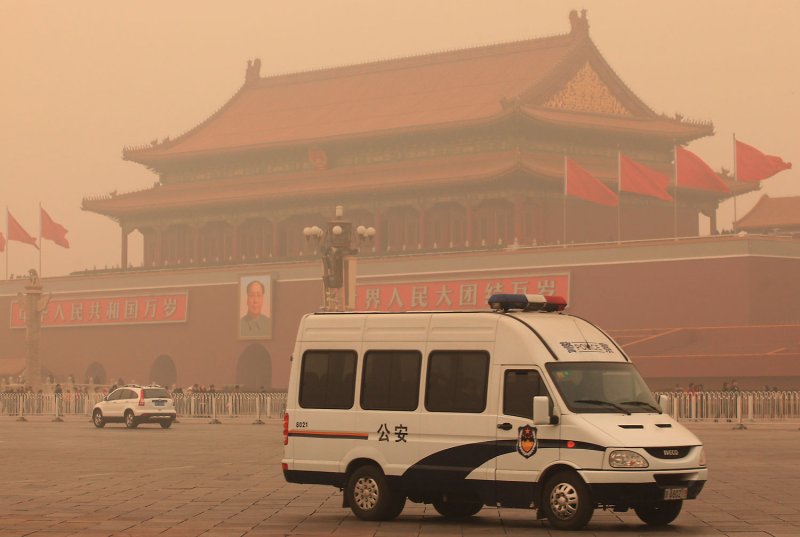Tiananmen Square sits under a thick blanket of smog, which the U.S. Embassy's daily air index has rated as hazardous, darkening the afternoon sun in Beijing January 18, 2012. Air pollution in China's capital has been so bad that the air quality monitoring system used by the U.S. Embassy here has described the pollution as being off the scale. The World Bank reports that 16 of the 20 most polluted cities in the world are in China, with Beijing being the 10th most polluted capital. UPI/Stephen Shaver |
License Photo
BEIJING, Feb. 9 (UPI) -- Beijing announced a series of measures aimed at reducing air pollution in the city, specifically targeting a reduction in readings of PM2.5, or fine particulate matter, in the air.
Under the plan, Beijing hopes to reduce the PM2.5 reading from the current 70 micrograms per cubic meter of air on average per year to 50 micrograms, or 30 percent, by 2020, Beijing Daily reported Wednesday.
China's Ministry of Environmental Protection previously said new monitoring standards and air quality appraisal systems would be released soon, to be adopted nationally by 2016. But those national standards would be far more rigid than what Beijing is aiming for.
Based on ministry hearings last month, the future national PM2.5 standard could be set at 35 micrograms per cubic meter of air on average per year.
China, the world's biggest emitter of carbon dioxide, now measures air quality based on PM 10, which doesn't detect smaller particulate pollutants.
Typically, Beijing residents have relied on the U.S. embassy in Beijing for its air quality readings of PM2.5, which are posted on Twitter nearly on the hour.
"Using standards recommended by the World Health Organization, PM2.5 will better measure the air quality," Luo Yi, director of the China National Environmental Monitoring Center recently told state-run news agency Xinhua.
In 2007, a pilot program measuring PM2.5 levels was instituted in nine Chinese cities, including Shanghai, Tianjin and Guangzhou.
Beijing said that by the end of 2012 it will complete a network of 35 PM2.5 monitoring stations and establish a satellite remote sensing system to oversee the overall air quality.
In addition, heavy-polluting and energy-consuming companies in oil refining, petrochemical, cement, iron and steel sectors will be prohibited from opening new plants or expanding existing facilities.
Other measures include limiting Beijing's annual total consumption of coal to 10 million tons, 62 percent less than the amount estimated to be consumed by the end of 2015 and phasing out 1.6 million cars with outdated emissions systems.
Separately, China National Petroleum Corporation said Tuesday it signed an agreement with Beijing's municipal government to promote the use of liquefied natural gas in the city's public transport sector.
Under the agreement CNPC will provide 100 LNG-powered buses in the first half of this year.
In a statement announcing the initiative, CNPC said that PM2.5 emissions from an LNG-powered bus are 90 percent less than that of a diesel bus.















